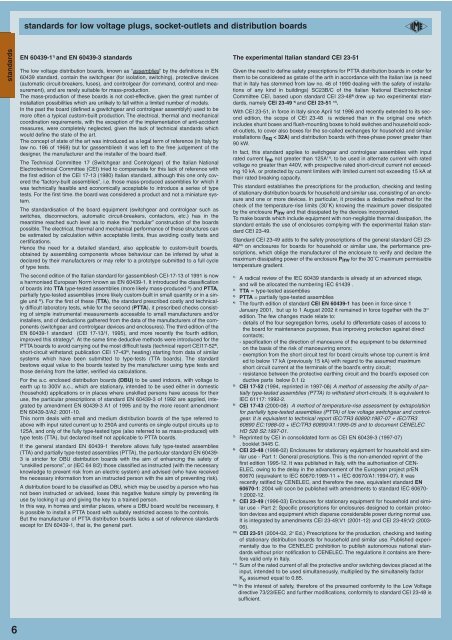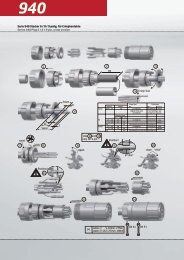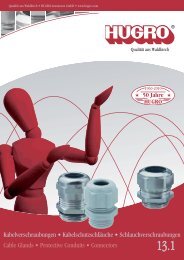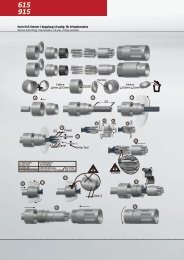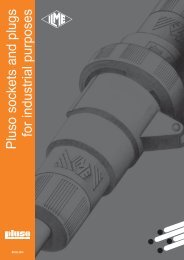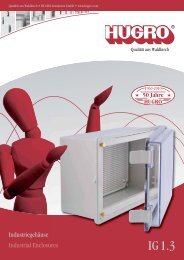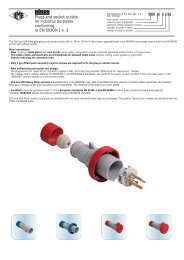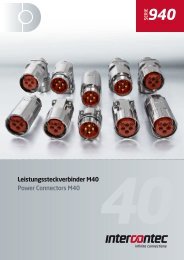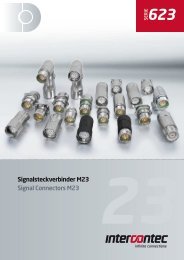TM Interlocked Socket Outlets - AP Technology
TM Interlocked Socket Outlets - AP Technology
TM Interlocked Socket Outlets - AP Technology
- No tags were found...
You also want an ePaper? Increase the reach of your titles
YUMPU automatically turns print PDFs into web optimized ePapers that Google loves.
standards for low voltage plugs, socket-outlets and distribution boardsstandardsEN 60439-1 1) and EN 60439-3 standardsThe low voltage distribution boards, known as “assemblies” by the definitions in EN60439 standard, contain the switchgear (for isolation, switching), protective devices(automatic circuit-breakers, fuses), and controlgear (for command, control and measurement),and are rarely suitable for mass-production.The mass-production of these boards is not cost-effective, given the great number ofinstallation possibilities which are unlikely to fall within a limited number of models.In the past the board (defined a gswitchgear and controlgear assemblyh) used to bemore often a typical custom-built production. The electrical, thermal and mechanicalcoordination requirements, with the exception of the implementation of anti-accidentmeasures, were completely neglected, given the lack of technical standards whichwould define the state of the art.The concept of state of the art was introduced as a legal term of reference (in Italy bylaw no. 186 of 1968) but for gassembliesh it was left to the free judgement of thedesigner, the manufacturer and the installer of the board itself.The Technical Committee 17 (Switchgear and Controlgear) of the Italian NationalElectrotechnical Committee (CEI) tried to compensate for this lack of reference withthe first edition of the CEI 17-13 (1980) Italian standard, although this one only coveredthe “factory-built assemblies”, i.e. those mass-produced assemblies for which itwas technically feasible and economically acceptable to introduce a series of typetests. For the first time. the board was considered a product and not a miniature system.The standardisation of the board equipment (switchgear and controlgear such asswitches, disconnectors, automatic circuit-breakers, contactors, etc.) has in themeantime reached such level as to make the “modular” construction of the boardspossible. The electrical, thermal and mechanical performance of these structures canbe estimated by calculation within acceptable limits, thus avoiding costly tests andcertifications.Hence the need for a detailed standard, also applicable to custom-built boards,obtained by assembling components whose behaviour can be inferred by what isdeclared by their manufacturers or may refer to a prototype submitted to a full cycleof type tests.The second edition of the Italian standard for gassembliesh CEI-17-13 of 1991 is nowa harmonised European Norm known as EN 60439-1. It introduced the classificationof boards into TTA type-tested assemblies (more likely mass-produced 2) ) and PTTA,partially type-tested assemblies (more likely custom-built in small quantity or in a singleunit 3) ). For the first of these (TTA), the standard prescribed costly and technicallydifficult laboratory tests, while for the second (PTTA), it prescribed checks consistingof simple instrumental measurements accessible to small manufacturers and/orinstallers, and of deductions gathered from the data of the manufacturers of the components(switchgear and controlgear devices and enclosures). The third edition of theEN 60439-1 standard (CEI 17-13/1, 1995), and more recently the fourth edition,improved this strategy 4) . At the same time deductive methods were introduced for thePTTA boards to avoid carrying out the most difficult tests (technical report CEI17-52 5) ,short-circuit withstand; publication CEI 17-43 6) , heating) starting from data of similarsystems which have been submitted to type-tests (TTA boards). The standardbestows equal value to the boards tested by the manufacturer using type tests andthose deriving from the latter, verified via calculations.For the a.c. enclosed distribution boards (DBU) to be used indoors, with voltage toearth up to 300V a.c., which are stationary, intended to be used either in domestic(household) applications or in places where unskilled persons have access for theiruse, the particular prescriptions of standard EN 60439-3 of 1992 are applied, integratedby amendment EN 60439-3 A1 of 1995 and by the more recent amendmentEN 60439-3/A2: 2001-10.This norm deals with small and medium distribution boards of the type referred toabove with input rated current up to 250A and currents on single output circuits up to125A, and only of the fully type-tested type (also referred to as mass-produced) withtype tests (TTA), but declared itself not applicable to PTTA boards.If the general standard EN 60439-1 therefore allows fully type-tested assemblies(TTA) and partially type-tested assemblies (PTTA), the particular standard EN 60439-3 is stricter for DBU distribution boards with the aim of enhancing the safety of“unskilled persons”, or (IEC 64 8/2) those classified as instructed (with the necessaryknowledge to prevent risk from an electric system) and advised (who have receivedthe necessary information from an instructed person with the aim of preventing risk).A distribution board to be classified as DBU, which may be used by a person who hasnot been instructed or advised, loses this negative feature simply by preventing itsuse by locking it up and giving the key to a trained person.In this way, in homes and similar places, where a DBU board would be necessary, itis possible to install a PTTA board with suitably restricted access to the controls.But the manufacturer of PTTA distribution boards lacks a set of reference standardsexcept for EN 60439-1, that is, the general part.The experimental Italian standard CEI 23-51Given the need to define safety prescriptions for PTTA distribution boards in order forthem to be considered as gstate of the arth in accordance with the Italian law (a needthat in Italy has stemmed from law no. 46 of 1990 dealing with the safety of installationsof any kind in buildings) SC23B/C of the Italian National ElectrotechnicalCommittee CEI, based upon standard CEI 23-48 8) drew up two experimental standards,namely CEI 23-49 9) and CEI 23-51 10) .With CEI 23-51, in force in Italy since April 1st 1996 and recently extended to its secondedition, the scope of CEI 23-48 is widened than in the original one whichincludes shunt boxes and flush-mounting boxes to hold switches and household socket-outlets,to cover also boxes for the so-called exchanges for household and similarinstallations (Inq < 32A) and distribution boards with three-phase power greater than90 kW.In fact, this standard applies to switchgear and controlgear assemblies with inputrated current Ine not greater than 125A 11) , to be used in alternate current with ratedvoltage no greater than 440V, with prospective rated short-circuit current not exceeding10 kA, or protected by current limiters with limited current not exceeding 15 kA attheir rated breaking capacity.This standard establishes the prescriptions for the production, checking and testingof stationary distribution boards for household and similar use, consisting of an enclosureand one or more devices. In particular, it provides a deductive method for thecheck of the temperature-rise limits (30˚K) knowing the maximum power dissipatedby the enclosure Pinv and that dissipated by the devices incorporated.To make boards which include equipment with non-negligible thermal dissipation, thestandard entails the use of enclosures complying with the experimental Italian standardCEI 23-49.Standard CEI 23-49 adds to the safety prescriptions of the general standard CEI 23-48 12) on enclosures for boards for household or similar use, the performance prescriptions,which oblige the manufacturer of the enclosure to verify and declare themaximum dissipating power of the enclosure Pinv for the 30˚C maximum permissibletemperature gradient.1)A radical review of the IEC 60439 standards is already at an advanced stage,and will be allocated the numbering IEC 61439 .2)TTA = type-tested assemblies3)PTTA = partially type-tested assemblies4)The fourth edition of standard CEI EN 60439-1 has been in force since 1January 2001, but up to 1 August 2002 it remained in force together with the 3 rdedition. The few changes made relate to:- details of the four segregation forms, useful to differentiate cases of access tothe board for maintenance purposes, thus improving protection against directcontacts;- specification of the direction of manoeuvre of the equipment to be determinedon the basis of the risk of manoeuvring errors;- exemption from the short circuit test for board circuits whose top current is limited to below 17 kA (previously 15 kA) with regard to the assumed maximumshort circuit current at the terminals of the board’s entry circuit;- resistance between the protective earthing circuit and the board’s exposed conductive parts below 0.1 Ω5)CEI 17-52 (1994, reprinted in 1997-08) A method of assessing the ability of partiallytype-tested assemblies (PTTA) to withstand short-circuits. It is equivalent toIEC 61117: 1992-2.6)CEI 17-43 (2000-08) A method of temperature-rise assessment by extrapolationfor partially type-tested assemblies (PTTA) of low voltage switchgear and controlgear.It is equivalent to technical report IEC/TR3 60890:1987-07 + IEC/TR360890 EC:1988-03 + IEC/TR3 60890/A1:1995-05 and to document CENELECHD 528 S2:1997-01.7)Reprinted by CEI in consolidated form as CEI EN 60439-3 (1997-07), booklet 3445 C.8)CEI 23-48 (1998-02) Enclosures for stationary equipment for household and similaruse - Part 1: General prescriptions. This is the non-amended reprint of thefirst edition 1995-12. It was published in Italy, with the authorisation of CEN-ELEC, owing to the delay in the advancement of the European project prEN60670 (equivalent to IEC 60670:1989-11 + IEC 60670/A1:1994-07). It wasrecently ratified by CENELEC, and therefore the new, equivalent standard EN60670-1: 2004 will soon be published with amendments to standard IEC 60670-1:2002-12.9)CEI 23-49 (1996-03) Enclosures for stationary equipment for household and similaruse - Part 2: Specific prescriptions for enclosures designed to contain protectiondevices and equipment which disperse considerable power during normal use.It is integrated by amendments CEI 23-49;V1 (2001-12) and CEI 23-49;V2 (2003-06).10)CEI 23-51 (2004-02, 2 a Ed.) Prescriptions for the production, checking and testingof stationary distribution boards for household and similar use. Published experimentallydue to the CENELEC prohibition to publish autonomous national standardswithout prior notification to CENELEC. The regulations it contains are thereforevalid only in Italy.11)Sum of the rated current of all the protective and/or switching devices placed at theinput, intended to be used simultaneously, multiplied by the simultaneity factorK e assumed equal to 0.85.12)In the interest of safety, therefore of the presumed conformity to the Low Voltagedirective 73/23/EEC and further modifications, conformity to standard CEI 23-48 issufficient.6


